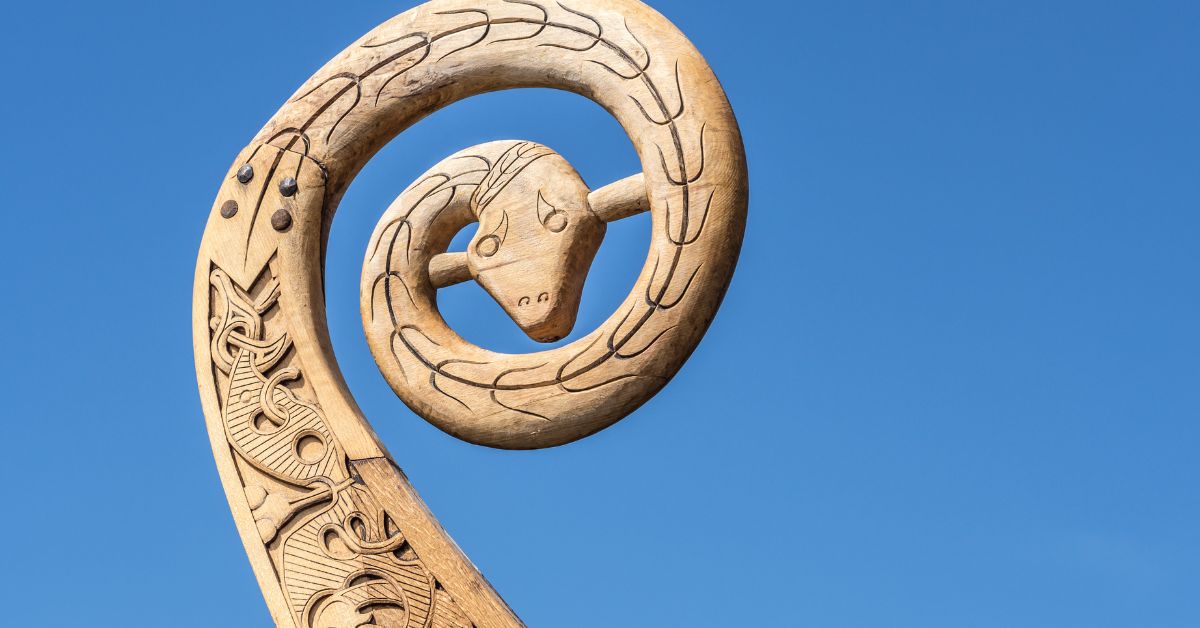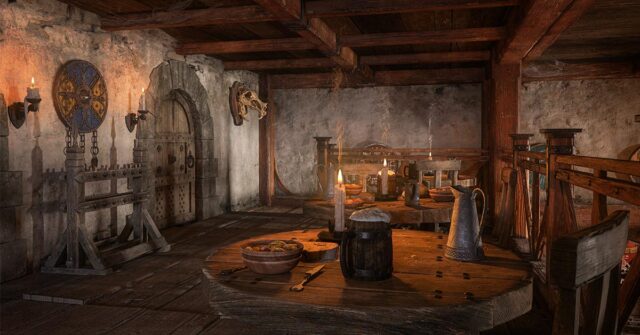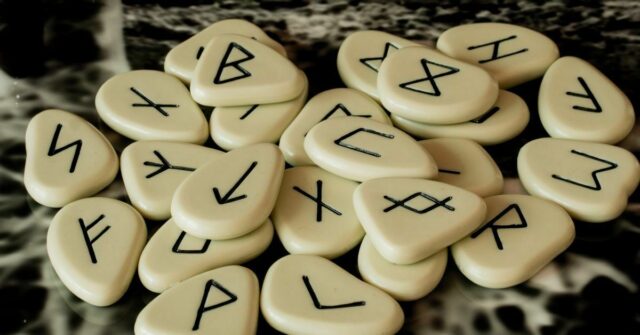Viking carvings offer an intricate glimpse into the artistry and cultural richness of the Viking Age.
These carvings, found on ships, tools, and various artifacts, showcase the skilled craftsmanship and symbolic depth of the Norse people.
From mythical creatures to geometric patterns, each carving tells a story about the beliefs and daily life of the Vikings.
Introduction
The art of Viking carvings is a fascinating subject that combines historical significance with artistic beauty.
These carvings not only served decorative purposes but also had cultural and symbolic meanings that were deeply intertwined with Norse mythology and Viking society.
Understanding the intricacies of Viking carvings helps us appreciate the craftsmanship and the cultural context in which these artworks were created.
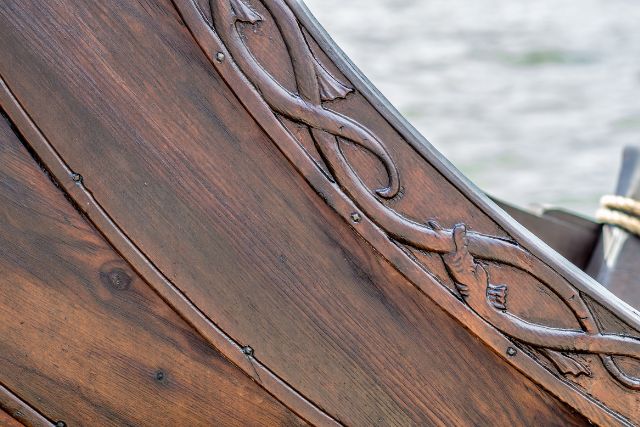
The Rich History of Viking Art
The Viking Age, spanning from the late 8th to the early 11th century, was a period of significant cultural development in Scandinavia.
One of the most fascinating aspects of this era is the rich and intricate art produced by the Vikings.
Their carvings, which adorned ships, buildings, and everyday objects, reflect their complex mythology, social structures, and interactions with other cultures.
These artworks provide a window into the lives and beliefs of people who were more than just raiders and warriors; they were also skilled artisans and traders.
Why Viking Carvings Matter
Viking carvings are not merely decorative; they are historical records etched in wood, metal, and stone. These carvings offer insights into Viking society, including their mythology, craftsmanship, and daily life.
The symbolic meanings embedded in these works help us understand the spiritual and cultural priorities of the Vikings.
Studying these carvings allows historians and archaeologists to piece together the past, shedding light on a civilization that has greatly influenced the modern world.
Styles of Viking Art
Viking art is distinguished by various styles that evolved over centuries, each reflecting different aspects of Norse culture and interaction with other societies.
These styles, including Oseberg, Borre, Jellinge, Mammen, Ringerike, and Urnes, highlight the diversity and complexity of Viking artistic expression.
Exploring these styles reveals the evolution of Viking art and its impact on the broader artistic traditions of medieval Europe.
Oseberg Style
The Oseberg style, named after the famous Oseberg ship burial discovered in Norway, is characterized by its elaborate and sophisticated animal motifs.
This style is notable for its flowing, ribbon-like animals that intertwine and overlap in complex patterns.
The Oseberg ship itself is adorned with such carvings, showcasing the Vikings’ exceptional skill in woodwork.
These carvings often depict animals like serpents and dragons, reflecting the mythological creatures that were integral to Viking lore.
Characteristics and Examples
The Oseberg style features animals with elongated bodies, often with their heads turned backward. The intricate interlacing of these forms creates a sense of movement and vitality.
A prime example of this style is the Oseberg ship’s prow, which is carved with a gripping beast motif, a creature holding its own body or another object in its claws.
Symbolism in Oseberg Carvings
Oseberg carvings often symbolize protection and power, qualities highly valued by the Vikings.
The dragons and serpents carved into the ship are thought to guard against evil spirits and misfortune during voyages.
These symbols also reflect the Vikings’ belief in a world populated by powerful deities and mythical creatures.
Borre Style
The Borre style emerged in the mid-9th century and is named after a ship burial site in Borre, Norway.
This style is recognized for its tightly interwoven knot patterns and gripping beasts, which are often depicted in symmetrical arrangements.
The Borre style was widespread, appearing in regions as far-reaching as the British Isles and Russia.
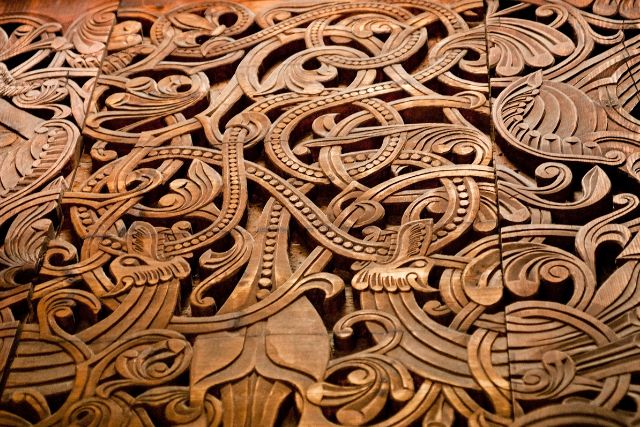
Distinctive Features
Characteristics of the Borre style include the use of ring chains, where ribbon-like shapes are interlaced to form continuous patterns.
These patterns are densely packed, with the background almost entirely obscured. The gripping beast, a central motif, is often shown with its claws clutching various parts of its body or the surrounding design.
Notable Artifacts
Artifacts featuring the Borre style include jewelry such as brooches and pendants, as well as everyday items like combs and buckles.
The gold spur from Verne Kloster in Norway is a notable example, showcasing the intricate knotwork and detailed animal figures typical of this style.
Jellinge Style
The Jellinge style, which flourished during the 10th century, is named after a silver cup found in a royal burial mound in Jelling, Denmark.
This style is known for its more fluid and open compositions, with S-shaped animals and interlacing patterns.
Design Elements
The Jellinge style features animals with double-contoured bodies, round eyes, and tendrils extending from their heads.
These animals are often intertwined with ribbon-like forms, creating a dynamic and flowing design.
This style represents a transition from the denser Borre patterns to the more open and expansive designs of the later Mammen style.
Influence and Spread
Jellinge style carvings have been found across Scandinavia, as well as in areas influenced by Viking expansion, such as the British Isles and Eastern Europe.
The style’s influence extended to stone carvings, textiles, and metalwork, illustrating its widespread appeal and adaptability.
Mammen Style
The Mammen style, named after a grave find in Mammen, Denmark, emerged in the late 10th century.
This style is characterized by its intricate and detailed designs, often featuring plant motifs and large, bold animals.
Evolution from Jellinge
Building on the Jellinge style, Mammen carvings are more elaborate and detailed. The animal figures in Mammen art are typically larger and more dynamic, often depicted in action poses.
Plant motifs, such as vine scrolls and leaf patterns, are also prominent, adding to the complexity of the designs.
Iconic Pieces
Iconic examples of the Mammen style include the axe head from the Mammen grave, which features a large, stylized bird surrounded by intricate plant motifs.
This style is also evident in textiles and metalwork from the period, demonstrating its broad application and appeal.
Ringerike Style
The Ringerike style, named after a region in Norway, developed around the early 11th century. It is characterized by its elegant, flowing lines and intricate plant motifs, often combined with animal figures.
Characteristics and Development
Ringerike carvings are noted for their graceful curves and detailed patterns. The style often features animals with elongated bodies and intricate vine scrolls, creating a sense of movement and fluidity.
This style represents a refinement of earlier Viking art, incorporating more sophisticated and delicate designs.
Examples of Ringerike Art
Examples of Ringerike art include runestones and church decorations, such as the carved wooden portal from Urnes Stave Church.
These carvings showcase the style’s characteristic elegance and attention to detail.
Urnes Style
The Urnes style, which emerged in the late 11th century, is named after the Urnes Stave Church in Norway.
This style represents the final phase of Viking art, characterized by its slender, interlacing animal figures and intricate patterns.
Distinctive Features
Urnes carvings are distinguished by their thin, ribbon-like animals and elaborate interwoven patterns.
The designs are often more abstract and stylized than earlier Viking art, reflecting the influence of continental European styles.
Significant Artifacts
Significant artifacts in the Urnes style include the carved wooden panels from Urnes Stave Church, which depict sinuous animal figures intertwined with intricate vine scrolls.
These carvings demonstrate the high level of craftsmanship and artistic sophistication achieved by Viking artists in this period.
Techniques and Materials
The techniques and materials used by Viking carvers were both practical and sophisticated, enabling them to create intricate designs that have stood the test of time.
From wood and metal to stone, each material required specific tools and methods.
Understanding these techniques provides insight into the daily lives of Viking artisans and the tools they used to bring their artistic visions to life.
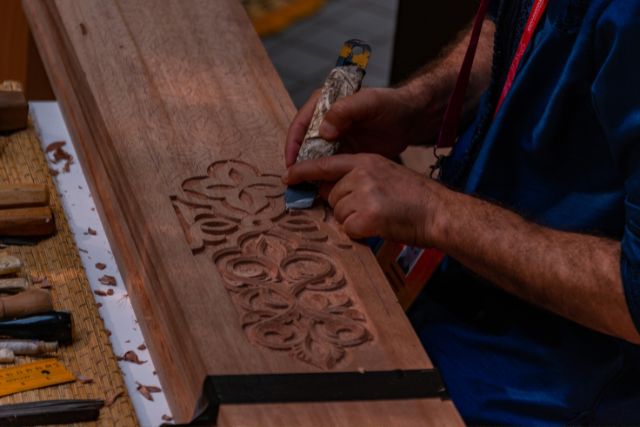
Wood Carving Methods
Viking wood carving was a highly skilled craft, requiring a variety of tools and techniques. Carvers used axes, adzes, and knives to shape and detail their works, creating intricate patterns and motifs.
Tools of the Trade
The primary tools for Viking carvers included axes for rough shaping, adzes for smoothing, and knives for fine details.
These tools allowed carvers to create a range of textures and patterns, from deep cuts to delicate incisions.
Techniques and Processes
Carvers typically began with a rough outline of the design, gradually refining it with smaller tools.
The process required a deep understanding of the wood’s grain and properties, as well as a steady hand and a keen eye for detail.
Techniques such as chip carving and relief carving were commonly used to create intricate designs.
Materials Used in Viking Carvings
Viking carvers used a variety of materials, each chosen for its suitability to the intended purpose and design.
The most common materials were wood, metal, and stone, each offering different possibilities for artistic expression.
Wood Types
Common woods used by Viking carvers included oak, pine, and birch. Oak was prized for its strength and durability, making it ideal for shipbuilding and large structures.
Pine and birch were more readily available and easier to work with, making them popular for smaller items and everyday objects.
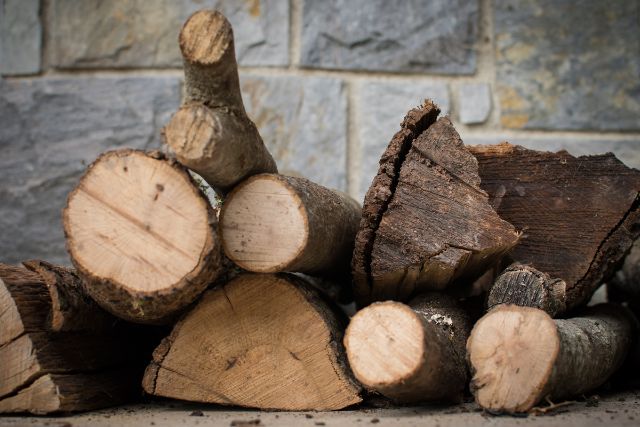
Other Materials: Metal and Stone
In addition to wood, Viking artisans also worked with metal and stone. Metal items, such as jewelry and weapons, were often decorated with intricate carvings and inlays.
Stone carvings, including runestones and grave markers, featured elaborate patterns and inscriptions, showcasing the Vikings’ skill in working with harder materials.
Symbolic Meanings in Viking Carvings
Viking carvings are rich in symbolic meanings, reflecting the spiritual and cultural beliefs of the Norse people.
These symbols often depicted mythological scenes, animals, runes, and geometric patterns, each carrying specific meanings.
Analyzing these symbols helps us decode the messages and stories that Viking artists intended to convey through their work.
Common Symbols and Their Interpretations
Viking carvings are rich in symbolism, with each motif carrying specific meanings and associations.
These symbols provide insight into the Vikings’ beliefs and values, reflecting their worldview and spiritual practices.
The Tree of Life
The Tree of Life is a central symbol in Viking carvings, representing the interconnectedness of all things.
Known as Yggdrasil in Norse mythology, this immense tree connects the nine worlds and serves as a bridge between heaven, earth, and the underworld.
Carvings of the Tree of Life often feature elaborate roots and branches, symbolizing growth, continuity, and the cyclical nature of life.
This motif underscores the Vikings’ belief in the unity of the cosmos and the eternal cycle of creation and destruction.

Animal Representations
Animals are a common motif in Viking carvings, each species imbued with specific symbolic meanings. For instance, the raven is associated with the god Odin and represents wisdom, war, and death.
The wolf, connected to the god Fenrir, symbolizes chaos and destruction but also power and ferocity. Other animals, such as bears and eagles, represent strength and courage.
These animal motifs were not just decorative but conveyed messages about the wearer’s or owner’s attributes and virtues.
Runes and Their Meanings
Runes were more than just letters to the Vikings; they were potent symbols used for communication, magic, and divination. Each rune had its own meaning and power.
For example, the rune ‘Fehu’ represented wealth and prosperity, while ‘Uruz’ symbolized strength and health. Carvings often included runes to invoke protection, luck, or specific qualities.
The use of runes in carvings added a layer of meaning and connected the artwork to the spiritual practices of the Vikings.
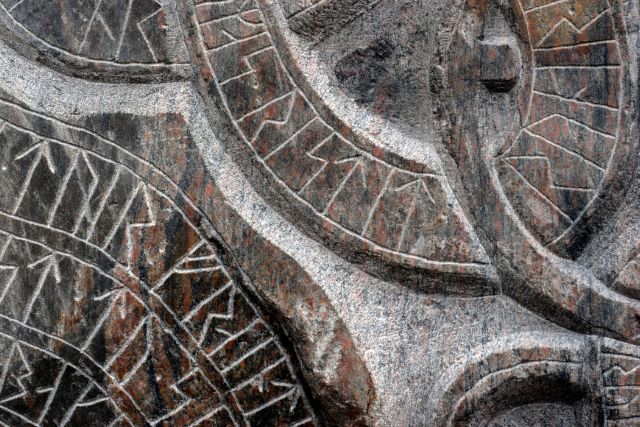
Geometric Patterns
Geometric patterns in Viking carvings are not merely decorative but carry deep symbolic meanings.
These patterns often represent the cycles of life, such as birth, death, and rebirth, and the idea of balance and harmony in the universe.
Common geometric motifs include spirals, which symbolize the continuous flow of time and energy, and knotwork, which represents the interconnectedness of life and eternity.
These intricate designs reflect the Vikings’ sophisticated understanding of the world and their place within it.
Cultural and Historical Context
The cultural and historical context of Viking carvings is crucial to understanding their significance.
These carvings were not created in isolation but were influenced by the Vikings’ interactions with other cultures through trade, exploration, and conquest.
Examining the context in which these artworks were produced reveals much about the social, religious, and economic aspects of Viking life.
The Role of Carvings in Viking Society
Viking carvings played a significant role in everyday life and were more than mere decorations.
They adorned practical items such as ships, tools, and household objects, imbuing them with beauty and meaning.
These carvings also served ritualistic purposes, being used in religious ceremonies and funerary practices.
The detailed craftsmanship found in carvings on burial ships, like the Oseberg and Gokstad ships, indicates their importance in honoring the deceased and ensuring their safe passage to the afterlife.
Everyday Objects and Decorations
In Viking society, everyday objects were often elaborately decorated with carvings. Items such as combs, bowls, and furniture featured intricate designs that reflected both personal and cultural identity.
These objects were not just utilitarian but also conveyed the owner’s status and aesthetic sensibilities.
The widespread use of carvings on everyday items highlights the importance of art and beauty in Viking daily life.
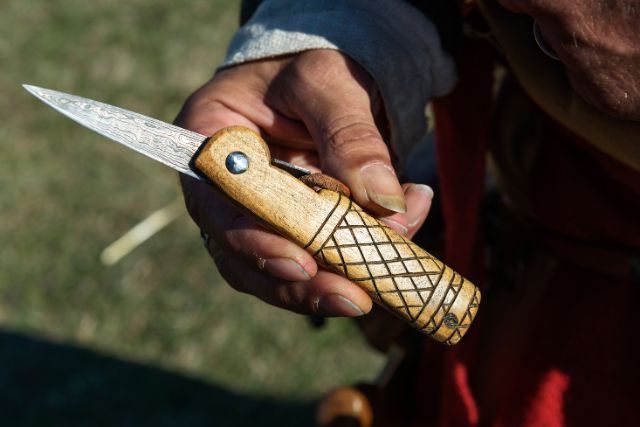
Ritualistic and Funerary Uses
Carvings played a crucial role in Viking rituals and funerary practices.
Ships used for burials, such as the Oseberg ship, were intricately carved with protective and symbolic motifs to safeguard the deceased on their journey to the afterlife.
These carvings often depicted scenes from Norse mythology, ensuring the deceased’s connection to their gods and ancestors.
Funerary carvings also included runestones, which commemorated the dead and told their stories for future generations.
Influences from Trade and Exploration
The Vikings were not isolated; their extensive trade networks and exploratory ventures exposed them to various cultures. This interaction led to the incorporation of foreign artistic elements into Viking carvings.
Artifacts found in Viking settlements show influences from Celtic, Anglo-Saxon, and even Islamic art, indicating a fusion of styles that enriched Viking artistic traditions.
Integration of Foreign Styles
As the Vikings traveled and traded, they encountered and integrated elements from other cultures into their own art.
Celtic knotwork, for example, influenced Viking designs, leading to more complex and interwoven patterns in their carvings.
Similarly, motifs from Eastern cultures, such as intricate geometric designs, were adapted and incorporated into Viking art.
This blending of styles created a unique and diverse artistic expression that reflected the Vikings’ broad horizons.
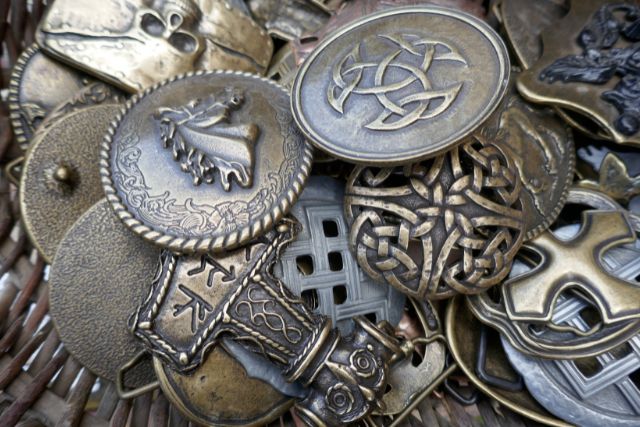
Impact of Christianity
The spread of Christianity had a significant impact on Viking art. As the Vikings converted, Christian symbols and themes began to appear in their carvings.
Crosses, saints, and biblical scenes were incorporated alongside traditional Norse motifs, creating a distinctive blend of pagan and Christian imagery.
This transition is evident in artifacts from the later Viking period, which show a gradual shift towards Christian iconography while retaining elements of traditional Viking art.
Famous Viking Carvings
Several famous Viking carvings, such as those on the Oseberg and Gokstad ships, stand out for their artistic excellence and historical importance.
These carvings provide valuable insights into Viking shipbuilding, burial practices, and artistic traditions.
Studying these masterpieces allows us to appreciate the high level of craftsmanship achieved by Viking artisans.
The Oseberg Ship
The Oseberg ship, discovered in a burial mound in Norway, is one of the most famous examples of Viking wood carving.
The ship’s prow is adorned with intricate carvings of intertwined animals and mythical creatures, showcasing the Vikings’ exceptional craftsmanship.
These carvings are not only decorative but also serve to protect and guide the deceased on their journey to the afterlife.
The Oseberg ship provides a remarkable glimpse into the artistry and beliefs of the Viking Age.
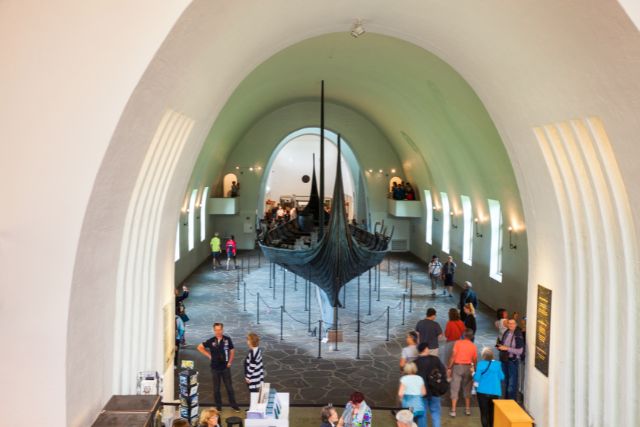
Historical Background
The Oseberg ship was buried around 834 AD and discovered in 1904. It contained the remains of two women, along with a wealth of grave goods, including carved wooden artifacts, textiles, and tools.
The ship’s burial indicates the high status of the individuals interred and provides valuable insights into Viking burial practices and societal structures.
Detailed Analysis of Carvings
The carvings on the Oseberg ship are among the finest examples of Viking art. The prow features a gripping beast motif, with animals intricately intertwined in complex patterns.
These designs reflect the Vikings’ belief in the protective power of such symbols.
Other carvings on the ship include scenes from Norse mythology, demonstrating the cultural significance of these stories in Viking life.
The detailed craftsmanship and artistic skill evident in these carvings highlight the sophistication of Viking artisans.
The Gokstad Ship
The Gokstad ship, another famous Viking burial ship, was discovered in 1880 in a burial mound in Norway.
This ship is larger and more robust than the Oseberg ship, reflecting its use in voyages across the open sea.
The carvings on the Gokstad ship, while less ornate than those on the Oseberg ship, still showcase the Vikings’ skill in woodwork and their attention to detail.
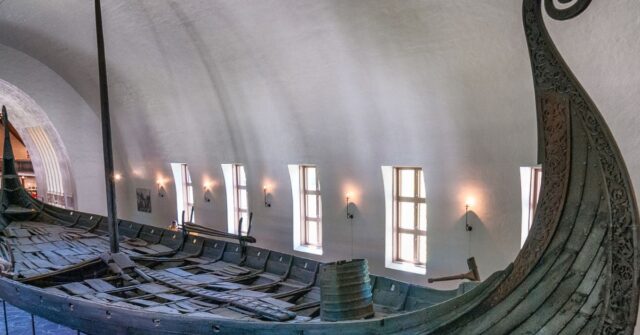
Artistic Significance
The Gokstad ship’s carvings are simpler but no less significant than those on the Oseberg ship.
The designs focus on practical elements, such as reinforcing the ship’s structure, while still incorporating decorative motifs.
These carvings provide a different perspective on Viking art, emphasizing functionality alongside beauty.
Carving Highlights
Highlights of the Gokstad ship’s carvings include the dragon-head post, which served as a protective symbol, and the intricately carved shields that lined the ship’s sides.
These carvings, while more utilitarian, still reflect the Vikings’ appreciation for artistry and their belief in the power of symbolic designs.
Modern Revival of Viking Carving Techniques
In recent years, there has been a renewed interest in Viking carving techniques, with contemporary artists and historians working to revive and preserve these ancient skills.
This revival not only honors Viking heritage but also brings traditional techniques into the modern era, creating a bridge between past and present.
Exploring these efforts highlights the enduring legacy of Viking art.
Contemporary Artists and Their Work
Today, there is a growing interest in reviving Viking carving techniques.
Modern artisans are studying historical artifacts and using traditional tools and methods to create new works inspired by Viking art.
These contemporary pieces not only celebrate Viking heritage but also bring this ancient art form into the present day.
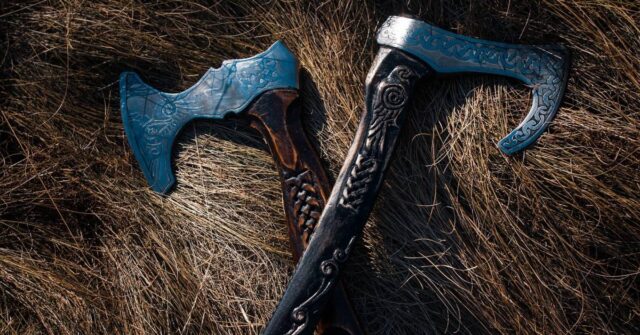
Traditional Techniques in Modern Times
Contemporary carvers often use traditional Viking tools, such as axes and knives, to replicate the techniques of the past.
This approach allows them to create works that are faithful to historical styles while adding their own creative touches.
Workshops and classes on Viking carving techniques are also becoming popular, helping to preserve and pass on these skills to future generations.
Innovations and New Approaches
While many modern artists focus on traditional methods, others are incorporating new technologies, such as laser cutting and 3D printing, to create innovative Viking-inspired pieces.
These new approaches allow for greater precision and creativity, expanding the possibilities of what can be achieved with Viking carving techniques.
The blending of old and new methods is leading to a renaissance in Viking art, making it more accessible and relevant to contemporary audiences.
Preservation and Restoration Efforts
Preserving and restoring Viking carvings is a complex and ongoing task. Many artifacts are fragile and have suffered from centuries of exposure to the elements.
Efforts to conserve these works involve careful cleaning, stabilization, and, in some cases, reconstruction using traditional methods.
Challenges in Preservation
One of the main challenges in preserving Viking carvings is the degradation of materials over time. Wood, in particular, is susceptible to rot and insect damage.
Conservators must use a combination of modern science and traditional techniques to stabilize these artifacts and prevent further deterioration.
This often involves delicate work under microscopes and the use of specialized chemicals to strengthen the material.
Success Stories
Several notable projects have successfully preserved and restored Viking carvings.
One such example is the reconstruction of the Oseberg ship, where conservators meticulously recreated the intricate carvings using traditional techniques and tools.
This project not only preserved the original artifacts but also provided valuable insights into Viking craftsmanship.
Another success story is the preservation of the Gokstad ship, which has been stabilized and displayed in the Viking Ship Museum in Oslo, allowing the public to appreciate these historical treasures.
These efforts demonstrate the importance of preserving Viking carvings for future generations to study and admire.
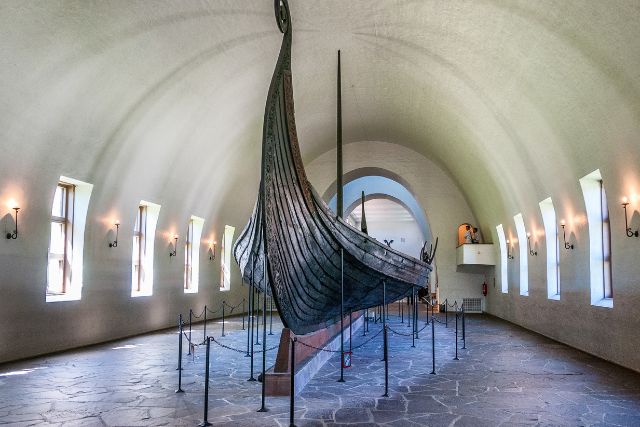
Conclusion
Viking carvings remain a testament to the artistic and cultural achievements of the Norse people.
By studying these intricate artworks, we gain a deeper understanding of the Viking Age and the values that shaped their society.
The legacy of Viking carvings continues to inspire and captivate, reminding us of the enduring power of art to connect us with our history.
The Lasting Legacy of Viking Carvings
Viking carvings continue to captivate and inspire people around the world.
Their intricate designs and deep symbolism offer a glimpse into the minds of the Vikings, revealing a culture rich in artistry and meaning.
The preservation and study of these carvings help us understand the values and beliefs of the Viking Age, ensuring that their legacy endures.
These artworks are not just historical artifacts but also a testament to the creativity and skill of the Viking people.
Why Viking Art Continues to Fascinate
Viking art remains a source of fascination due to its complexity, beauty, and the stories it tells.
The detailed carvings found on ships, jewelry, and everyday objects reveal a society that valued both functionality and aesthetics.
The myths and legends depicted in these carvings connect us to a distant past, allowing us to explore the rich tapestry of Viking culture.
As modern artists and enthusiasts continue to draw inspiration from Viking art, its influence persists, bridging the gap between ancient and contemporary worlds.
In summary, the study of Viking carvings offers a unique window into the past, shedding light on the artistic achievements and cultural practices of the Vikings.
By preserving and celebrating this heritage, we ensure that the intricate and fascinating world of Viking art remains alive and appreciated for generations to come.

